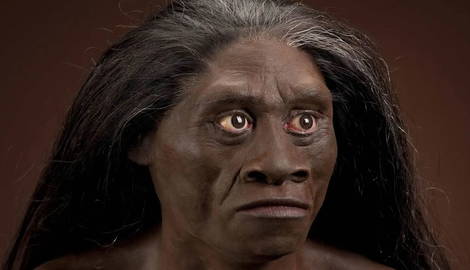
In 2003 in Liang Bua, a limestone cave on the island of Flores in Indonesia, a discovery was made that would radically alter the model of human evolution and change the way we think about human intelligence. This was the discovery of a human that stood 3 feet 7 inches (1.1 meters) tall as a fully grown adult. Similar findings then showed that this was not the result of a bone defect or disease. These people were healthy, and they were also tiny.
With Peter Jackson’s Lord of the Rings films fresh in the minds of the public, this little human was nicknamed “the Hobbit” and would later be classified as Homo floresiensis.
Evolution of Homo Floresiensis

In archeological terms, the species has been known for a very short time, and our knowledge of Homo floresiensis is still in its stages of infancy. What we have discovered so far has perplexed academics and forced us to rethink what our human ancestors did and what they were capable of.
As with all our evolutionary ancestors and their relatives, there is more than one competing theory for how H. floresiensis evolved. One widely supported theory is that H. floresiensis evolved from Homo erectus. Various cranial and skeletal shapes in H. floresiensis seem to indicate that this is indeed the case. Research based mainly on cranial evidence posits that H. erectus somehow crossed the water to reach the island of Flores, whereupon the group was subject to the evolutionary process of island/insular dwarfism. The process of island dwarfism occurs when isolated groups of animals, usually on an island, evolve to be smaller as a result of reduced resources.

Another theory for the evolution of H. floresiensis is that they evolved from an even older species than H. erectus. Various features of H. floresiensis resemble features found in earlier australopiths. The size of the legs and the feet, as well as the morphology of the teeth and mandible, suggest that H. floresiensis evolved from a hominid that predates H. erectus.
If this is the case, it opens up a major question about who these earlier hominids were and how they got to Flores while all their evolutionary peers were still in Africa. It also throws into doubt the classification of H. floresiensis in the Homo genus and suggests they should rather be classified as Australopithecus or even a new genus.
A third theory suggests that H. floresiensis was not a separate species at all but a group of H. erectus afflicted with a pathological condition such as myxo edematous endemic hypothyroidism (cretinism) or Laron syndrome.
What did Homo Floresiensis Look Like?

The most striking feature about Homo floresiensis is their small stature. The average height seems to have been around 3 feet 6 inches. They had receding foreheads and no chins. The widest part of the skull was around the ears, giving an appearance of a broad face. Their teeth were large relative to their skull and jaw size.
Their shoulders and clavicles were positioned slightly more forward than in modern humans. This made them look like they were shrugging.
They had stocky legs with relatively wide leg bones. Their feet were long in relation to their legs, and they would have had to bend their knees more while walking. This resulted in a slower walking gait.
Fossils & Stone Tool Evidence

To date, fossil evidence of 15 individuals have been found in the Liang Bua cave and span a period between 100,000 and 50,000 to 60,000 years ago. The individuals they represent have been classified as LB1 through LB15. LB was the first to be discovered and is the most complete skeleton. It is also the only individual for which we have the cranium.
Originally thought to be a possible example of microcephaly, the fossils of the other individuals’ teeth and mandibles showed that their heads were the same size. What is astonishing about these finds is that the cranial capacity of LB1 is only 380 cubic centimeters. Their brains were roughly the same size as those of chimpanzees and early australopiths. For comparison, the brain size of Homo erectus varied throughout its existence of over 1.5 million years but was significantly larger at 550 to 1250 cubic centimeters. Modern humans have cranial capacities of 1400 to 1500 cubic centimeters on average.
What is significant, however, is the evidence of their culture and behavior. Their tools consisted of flakes knapped into points, perforators, blades, and microblades, some of which show signs of being hafted (attached to a wooden haft) as barbs. Evidence of wear and polish on some stone tools shows that they were used for working with fibrous materials as well as wood.

It is likely that H. floresiensis constructed spears and spikes for use in traps. This was all in the name of hunting. Stone barbs found in the remains of small species of Stegodon, Stegodon florensis insularis (a species of extinct elephant), and cut marks on the bones suggest these animals were hunted and eaten by H. floresiensis. The stone tools attributed to H. floresiensis found at Liang Bua cave range in dates, with some being as old as 190,000 years. It suggests that H. floresiensis lived on the island of Flores for well over 100,000 years.
There is also evidence for controlled fire. Many of the rocks, lithic flakes, and Stegodon bones were burnt and charred, supporting the theory that H. floresiensis used fire for cooking. It is reasonable to assume they also used it for warmth and protection.
What is astonishing about all this is that their small brains did not seem to hamper them from creating and using technology that had, until the discovery of H. floresiensis, been thought to have been used only by Homo habilis and H. erectus, both of which had larger brains. It was assumed that brain size in hominids was directly proportional to the species’ intelligence, but H. floresiensis throws a very confusing new dynamic to this theory, as well as the evolutionary thought surrounding brain size and intelligence.
Life on the Island of Flores

Life would have been undoubtedly challenging for Homo floresiensis living on the island of Flores. Although they were surrounded by lush vegetation that would have provided many resources for tools and food, they were also surrounded by dangerous megafauna. Some of them, like the Stegodon, were dangerous to hunt, and others, such as Komodo dragons and Marabou storks, would have preyed on the diminutive hominids.
The bones of Marabou storks were also found in Liang Bua cave on the same stratum as H. floresiensis, indicating that these hominids likely preyed on these birds too. There were also several species of large rats that inhabited the island, which would most certainly have been hunted as prey. Two species have been found in Liang Bua cave: the Flores cave rat (Spelaeomys florensis) and the Flores giant rat (Papagomys armandvillei). The latter is still in existence, while the former is thought to have gone extinct a few hundred years ago.
The Legend of Ebu Gogo

Among the local inhabitants of the island of Flores, there is a legend of a small, mischievous humanoid creature known as Ebu Gogo, which translates roughly into English from the local Nage language as “old glutton.” These creatures of folklore were small and had broad faces, flat noses, and wide mouths. They were said to steal children to try to cook and eat them but were always outwitted by the smarter children.
Ethnologist Gregory Forth proposed the idea that the legend of Ebu Gogo is an oral tradition based on actual sightings of Homo floresiensis in prehistory. For many years after the discovery of H. floresiensis, it was believed that they had existed up until around 10,000 BCE. More modern dating has pushed their extinction back much further to about 50,000 to 60,000 BCE. Thus, while Forth’s theory proved interesting in the early years after the discovery of H. floresiensis, the idea has lost traction.
What Happened to Homo Floresiensis?

The disappearance of Homo floresiensis from the archeological record coincides with the arrival of modern humans to the region. It is unclear how Homo floresiensis went extinct. They may have simply been outcompeted for resources, but they may also have been hunted and killed like so many other animals that disappeared with the arrival of modern humans.
The existence of Homo floresiensis poses new questions and upsets what we previously theorized about human evolution. If this species evolved from Homo erectus, why do they display australopithecine traits that had disappeared in H. erectus? And if they evolved from an australopith, how did that species end up so far away from Africa?
In addition to these questions, we are struggling to understand how a hominid with such a small brain was capable of mental faculties far beyond what such a small brain would allow.
There is much to learn about this species, and every discovery adds a new piece to the puzzle of human evolution. What is sure is that Homo floresiensis presents a mysterious conundrum whose secrets will stay well hidden until we find more evidence to explain this little relative of ours.










